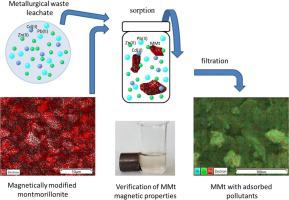Journal of Water Process Engineering ( IF 6.3 ) Pub Date : 2020-10-12 , DOI: 10.1016/j.jwpe.2020.101691 Michaela Tokarčíková , Jana Seidlerová , Oldřich Motyka , Ondřej Životský , Klára Drobíková , Roman Gabor

|
Using magnetic sorbents to pollutants eliminations seem to be an efficient, easy to apply and low-cost technique. However, the majority of studies focus on the study of sorption properties using model solutions and research on actual wastewater is largely missing. Therefore, this study aims to assess the application of magnetically modified montmorillonite (MMt) to eliminate Zn(II), Cd(II) and Pb(II) cations from metallurgical waste leachates. First, model solutions were prepared to describe the properties of MMt, sorption kinetic and isotherm models. The determined elimination efficiency was higher than 98 %. The qmax values were – in model solutions – determined to be 34.3, 2.84 and 7.25 mg/g for Zn(II), Cd(II) and Pb(II), respectively. Then, the MMt was applied in order to eliminate of Zn(II), Cd(II) and Pb(II) ions from actual metallurgical waste leachates. The experimental data obtained from the metallurgical waste leachates corresponded with the data obtained from the model solutions. The equilibrium metal uptake capacities obtained by heavy metals adsorption from model solution and metallurgical waste leachates followed the order: Zn(II) > Pb(II) > Cd(II) for dust leachates and Zn(II) > Cd(II) > Pb(II) for converter sludge leachates, which directly corresponds with the heavy metal ions concentration in the leachates. Moreover, the elimination of Zn(II), Cd(II) and Pb(II) by MMt was higher than 98 % even in the fifth recycling experiment cycle. After the sorption, the sorbent was still magnetically active, facilitating its removal from the solution. MMt proved to be an efficient and regenerable sorbent, applicable for wastewater treatment.
中文翻译:

可再生磁性改性蒙脱土的实验验证及其在冶金垃圾渗滤液中重金属去除的应用
使用磁性吸附剂消除污染物似乎是一种高效,易于应用且低成本的技术。然而,大多数研究集中于使用模型溶液研究吸附特性,而对实际废水的研究则大为缺失。因此,本研究旨在评估磁性改性蒙脱石(MMt)在冶金废渗滤液中消除Zn(II),Cd(II)和Pb(II)阳离子的应用。首先,准备模型溶液以描述MMt的特性,吸附动力学和等温线模型。所确定的消除效率高于98%。最大q在模型溶液中,Zn(II),Cd(II)和Pb(II)的值分别确定为34.3、2.84和7.25 mg / g。然后,应用MMt以便从实际的冶金废渗滤液中消除Zn(II),Cd(II)和Pb(II)离子。从冶金废渗滤液获得的实验数据与从模型溶液获得的数据相对应。重金属吸附从模型溶液和冶金废渗滤液中获得的平衡金属吸收能力的顺序为:粉尘渗滤液的Zn(II)> Pb(II)> Cd(II)和Zn(II)> Cd(II)> Pb (II)用于转炉污泥渗滤液,其直接对应于渗滤液中的重金属离子浓度。此外,即使在第五个循环实验周期中,MMt消除的Zn(II),Cd(II)和Pb(II)仍高于98%。吸附后,吸附剂仍具有磁性,从而易于从溶液中去除。事实证明,MMt是一种高效且可再生的吸附剂,适用于废水处理。







































 京公网安备 11010802027423号
京公网安备 11010802027423号